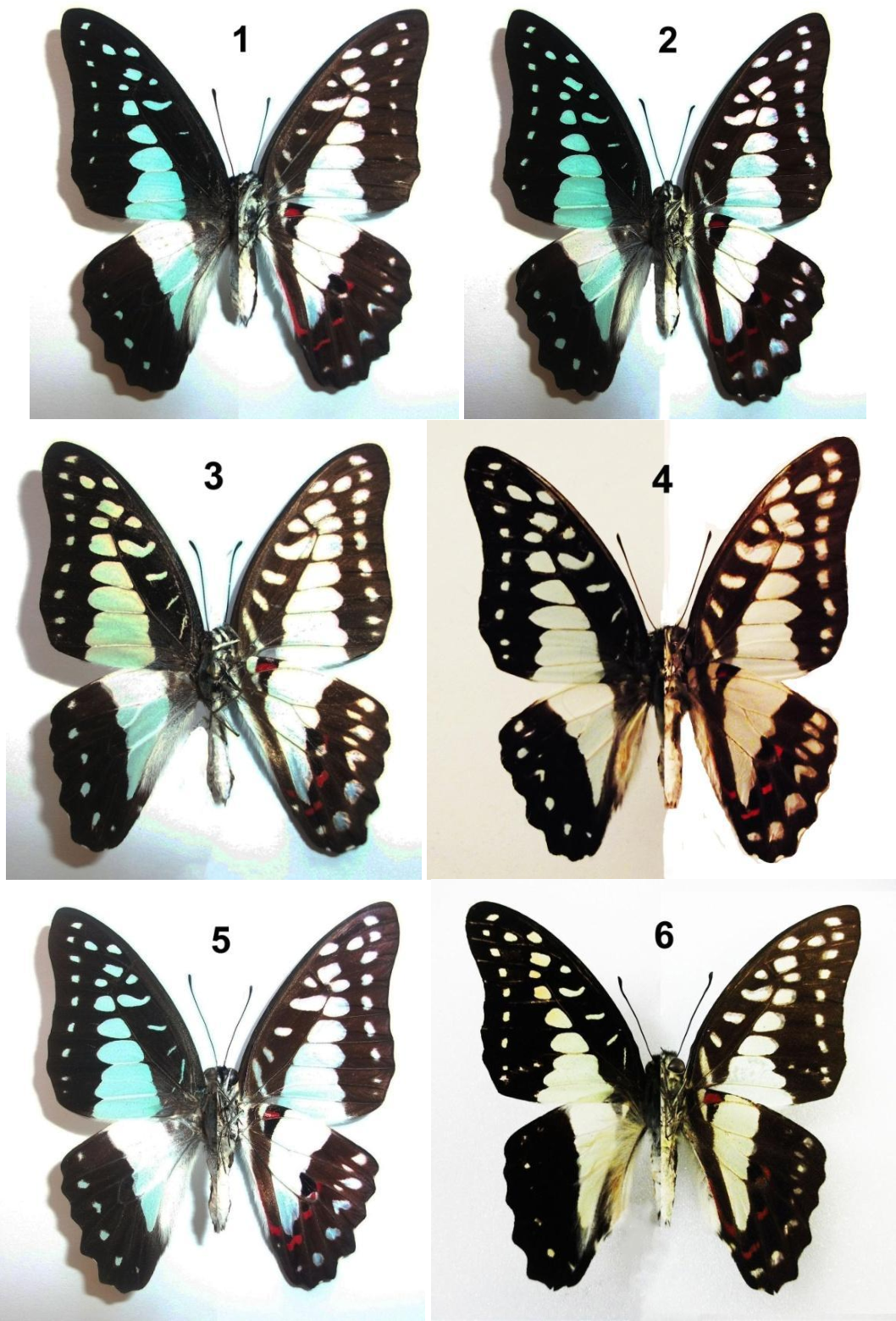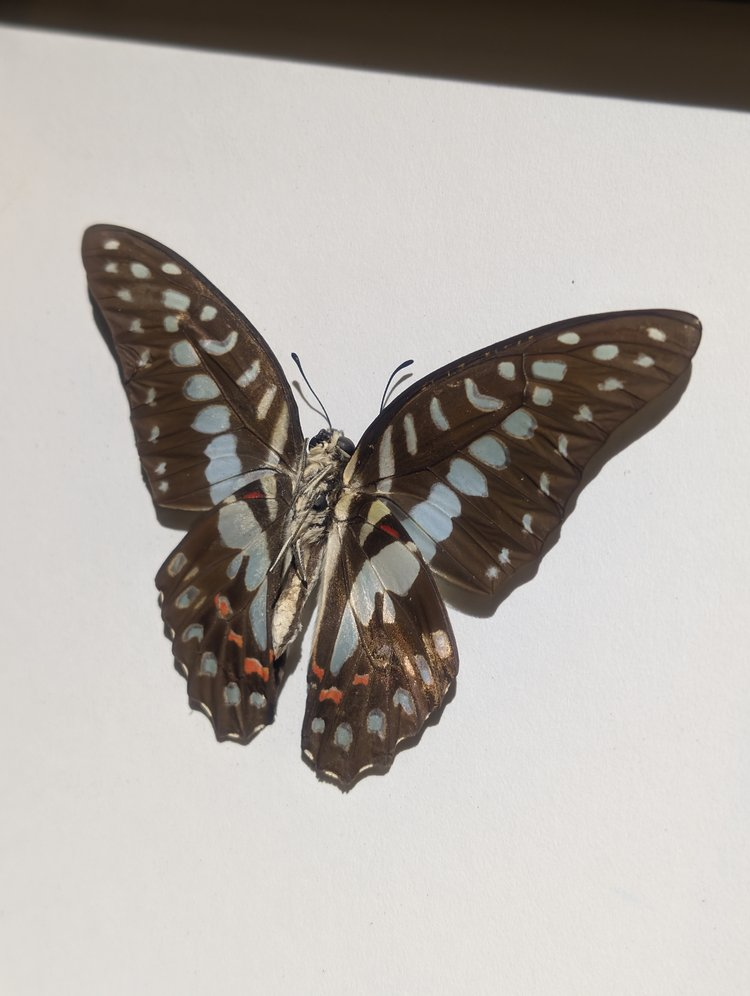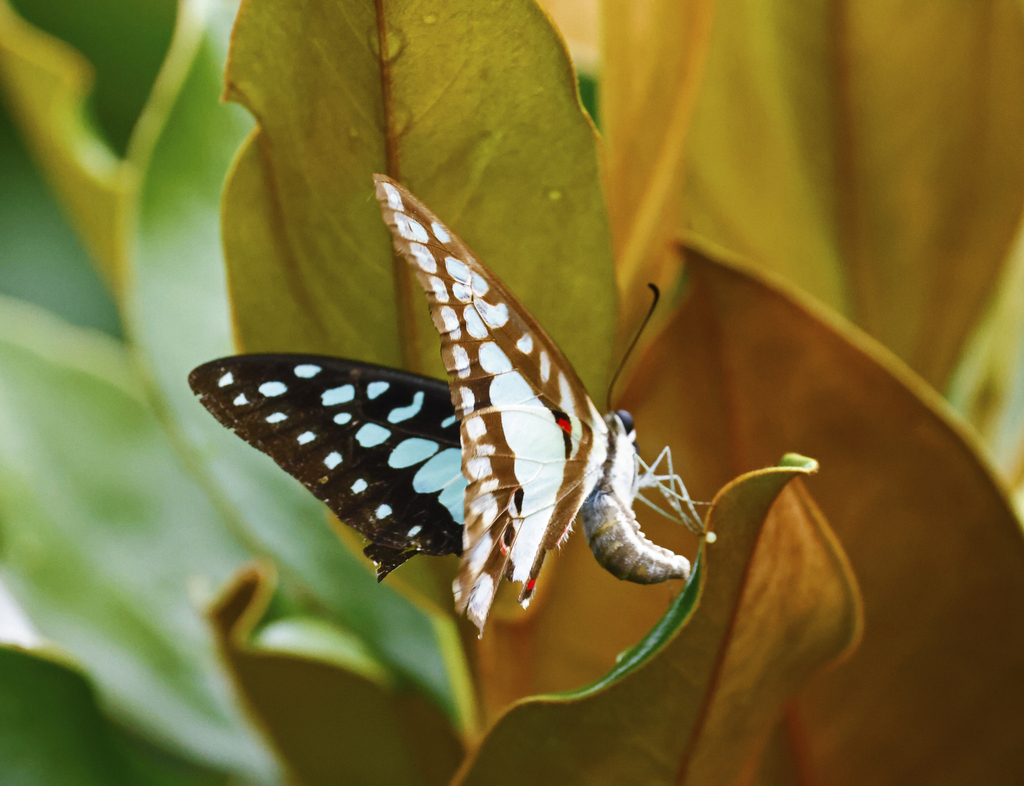Graphium eurypylus is fairly common across southern Asia and the Pacific islands as far east as Australia. It is sometimes called Pale Green Triangle, Pale Blue Triangle, or Pale Triangle. It is not paler, greener, or bluer than other Triangles. The shade of green or blue depends mostly on the angle at which the wings catch the light. It is also called Great Jay. It may be greater, in the sense of bigger, than other Jays; its wingspan can be close to five inches. However, many individual Graphium eurypylus are not bigger than other Jays.
In a once popular novel, The Great Gatsby, Jay Gatsby was a character who lost a great deal of money. I don't know that the butterfly carcass traffickers have a great deal of money to lose, but when I see Google suppressing science sites in order to make sure all the carcass traffickers' sites are represented in the puny handful of search results Google displays, I hope the carcass traffickers lose their shirts.
The genus name Graphium was given to a group of species distinguished from other Papilios (Swallowtails) by various physical features. Some now want to divide Graphium further and list this species as Arisbe eurypylus. In addition to Papilio, Graphium, and Arisbe, this species has also been called Chlorisses harrietta (by a naturalist who was out of contact with his colleagues), Semicaudati kochianus (ditto; it's hardly even semi-tailed), and Zetides eurypylus, or euryplus, or eurypilus.
"Eurypylus" comes from ancient Greek literature. Since it was the name of several characters, it's hard to say for whom Graphium eurypylus was named, but in the Iliad Eurypylus was the king of Thessaly and leader of its army. If a hero, he was a rather tragic one--he was killed for bringing bad news to another war chief on his own side. The name Graphium eurypylus might suggest the leader of an army when we consider the long list of subspecies names it "leads."
Not all of these subspecies appear on the same list. Some sources (like Page, below) prefer to classify some of them as distinct species. Some have dropped some older names and added newer ones. Where sources have given information about a subspecies, it appears below the subspecies' name on the list below.
acheron
Photo by Subhendukhan, who notes that this acheron's wingspan was over three inches. It is sometimes called the "Indo-Chinese Great Jay."
aloricus
Found at Alor.
arctofasciatus
Found on Sula island.
argenteus
Descriptions of argenteus and magnificus:
https://www.semanticscholar.org/paper/Notes-on-Graphium-eurypylus-Linnaeus%2C-1758-with-of-Goode/af405c375747b52d3ddab9df8f9de6a324713c5f. Relative to lycaonides and magnificus, argenteus have more conspicuous pale spots and are more likely to "shimmer" with "silver" color rather than iridesce blue or green. Average wingspan is only 9 cm or four inches--still a good-sized butterfly, but consistently smaller than lycaonides or magnificus. The three subspecies coexist in New Guinea.
aurifer (now thought to have been an aberrant form of either acheron or cheronus)
cheronus
Photo by Sebastien Delonglee, part of a gorgeous photo essay showing Graphium eurypylus cheronus (and perhaps other subspecies) at puddle parties with lots of other butterflies found in Vietnam. You must see the whole thing. Cheronus is also found in Sikkim, Burma, and China.
crispus
Found on Babber island.
crocospilus
Found in a collection shown to the great Walter Rothschild, who diagnosed its distinctive features as due to its being a "greasy or otherwise discolored specimen."
daton
eurypylides
Rothschild thought this subspecies was found only on a few islands. Later sources tend to lump it together with other subspecies and forget about it.
eurypylus
The basic eurypylus is found from Sikkim to Australia, not so much in India proper. Sikkim was part of India in Linnaeus' time, which may explain his saying its habitat was Indiis. Linnaeus also spelled the name euripylus. His admirers corrected that.
"
P. E. alisdentatis nigris: fafcia interrupta viridi; polus. fticis fubtus rubro maculatis. M. L. V.
Hahitat in Indiis.
Alae primores fubtus maculis 6 atro-fanguineis in difco. V^vhx maculis alarum alhis loco viridiutii ,,an fexu?
"
I read the word before maculis as Variat, and read the sentence as "Varying spots on the wings, white in place of green, according to sex?" I'm more confident about the rest of Linnaeus' remarks: "wings with border of black 'teeth'; interrupted bands of green; hind wings, underside, with red spots. Habitat in India" [Sikkim]."Fore wings, underside, 6 black and red spots in discal section." (The second half of the first line should be posticis subtus rubro maculatis.)
Rothschild's exhaustive discussion of the subspecies he recognized has also been digitally photographed for our perusal. It begins at
extensus
Found in the "New Britain" group of islands. The name refers to its hind wings being longer than other eurypylus'.
fumikoe
Found at Bunggai.
gabinus
georgius
gordion
heurni
insularis (or insularius)
Found on a few little-known Pacific islands, hence the name.
isaribi
juba (sometimes thought to be the same as cheronus, this subspecies still appears independently on some lists, but I found no informative web page for it)
kaicola
lepidus
Found at "Tenimber" or "Tanimbar."
lucius (thought to have been the same thing as insularius)
lutorius (sometimes, incorrectly, eutorius)
Found in some parts of Indonesia.
lycaon
Photo by Nhaass. Lycaon is found in eastern Australia. The border spots are much bigger on the underside than on the upperside of the wings, and some of the pale spots may look whiter rather than iridescing blue, green, or yellow due to loss of scales.
Photo from Martin Purvis. Brown-and-cream coloring as distinct from black-and-bluish-white is not a consistent gender indicator but is observed in this individual, photographed doing what female Swallowtails spend most of their lives doing--checking out leaf quality before laying an egg.
lycaonides
Photo from Papua-insects.com. Found on Papua and some nearby islands. Rothschild noted that some of the pale sections on its wings were not completely covered in scales. Though smaller than magnificus it still has an average wingspan of four inches.
macronius
Photo from Parthasarathy Gopalan. Macronius is the "Andaman Great Jay." The Andaman islands are close to the equator, but they're north of it; the butterflies fly in June.
madrimi (or madrmii)
magnificus
Photo from M. Goode. These museum pieces are, as numbered, magnificus, magnificus, argenteus, argenteus, lycaonides, and extensus. Goode discusses why magnificus and argenteus have been added (to some lists) as newer subspecies names at
Magnificus have fore wings typically 46 to 49 mm long, giving them a wingspan over 10 cm, four to five inches. Found on Papua, they are conspicuously bigger and more colorful than the other subspecies found there.
mecisteus
Photo by Antonio Giudici. Found in Thailand, some parts of Malaya, some Philippine islands, and as a visitor in Singapore.
melampus
Found on Kai island. This is another subspecies with extra-long, narrow wings. Rothschild's specimens had an average forewing length of 4.4 cm, giving the average butterfly a wingspan of over 9 cm or close to four inches.
mikado
Found in Japan. This may refer to Graphium doson mikado.
nyctimus
Photo by Tropicbreeze. Found in Australia and New Zealand, Graphium eurypylus nyctimus have their own Inaturalist page, which documents that they seem to share some other blue-iridescent Graphiums' attraction to bright blue surfaces. Bright blue sweaty (or soapy) fabric? Mineral salts! Scrummy yumboes! This species is found near the equator, above and below; in Australia the caterpillars are seen in November and December, and these butterflies are lekking in January.
Photo by Emilyjackjack, documenting that in some lights the white-to-blue patches on the wings can look yellow.
pamphylus
Photo by Selina Grazia. Native to Sulawesi, but sometimes found--as a stray, or escaped from captivity?--in Australia. Rothschild noted those long, arched forewings as its most conspicuous feature and also observed the small "linear" shape of the spots around the edges of the wings and white scent folds in the male's wings. This is the subspecies most likely to achieve a four-inch or wider wingspan. The body is a little bigger than other subspecies' bodies, but not twice the size, not in proportion to the wings.
pauli (Indonesia)
petina (probably just a variant form of cheronus)
praetorianus
priscus
rubroplaga
sallastius or sallastinus
Found on Sumbawa and Wetter islands. Some sources list these as two distinct subspecies found on slightly different, but overlapping, lists of islands.
sangira or sangirus
Found on Sangir island. Apparently it strays to Talaud and perhaps a few other islands, but it's not known to be resident anywhere but Sangir. Rothschild described it as having yellow instead of red spots on the underside of the hind wings, and black instead of gray or black and white on the upper side of the tail (abdomen) section of the body.
subhi
sulanus
tagalicus (thought to have been the same thing as gordion)
talboti
telephus
Some sources list subspecies axion and jason; more sources list jason as a distinct species and axion as a subspecies of Graphium doson. This web site has some photos and links for Graphium doson axion:
Page (2014) describes some of the lengths to which entomologists have gone in trying to devise a logical taxonomy that looks as though it explained how these subspecies, and the "closely related" look-alike species--including our Zebra Swallowtail--might have evolved into one another. These entomologists can't be accused of laziness. It would be much easier simply, scientifically, to accept the butterflies as they are and find out more about how they live, how they fit into their ecosystems, etc., as this web site attempts to do.
Here, entomologists try to classify images of living Graphiums drinking together at a puddle by species and subspecies. The nice clear photo of living butterflies is defaced with incorrect identifications, which are corrected by reference to other images below.
Some photos of couples show identical color patterns, and some show males with much brighter colors than females. Typically female Swallowtails are a little bigger and a little better camouflaged than males, but the human eye may not notice the difference or may notice it only in individuals where the difference shows up most clearly.
With such a wide range, we might expect that Graphium eurypylus can live in symbiosis with more than one kind of host plant, and so they do. Generally their hosts are Annonaceae, including soursop and custard-apple. They can be seen as pests, though symbionts help their hosts more than harm them. It made history when a mother eurypylus laid eggs on a plant in the magnolia family, instead, and caterpillars hatched and ate leaves.
Is it possible that subspecies of Graphium eurypylus are like those Hemileuca moths we don't have to read about every week any more? Food plant determines how the late-stage caterpillars and adult butterflies look, but some subspecies thrive on one plant and some on another? An Australian butterfly farm notes that eurypylus have been found eating fourteen different Annonaceae, but theirs "only seem to flourish on the soursop."
In Australia the butterflies may spend their lives in one place or migrate from place to place, presumably depending on population increases or decreases affecting the number of untouched food plants available. In "migration years" they visit places where they don't normally live. Despite their tolerance for large mixed crowds, migrating eurypylus can be territorial, at least as a show for status-seeking purposes. This observer describes a male eurypylus straying through their garden claiming ownership of the buddleia bush.
They seem to be one of the species in which males have to slurp up a certain amount of mineral salts, found in salt or brackish water or the run-off from dung or carrion, in order to be able to mate. What the child had stepped in is unrecorded, but Dhfischer documents a mixed species feeding frenzy on the left shoe only of a child who took off his shoes to go swimming.
This photo by SL Liew adds nothing new to what we've learned about the species. It is included here as a celebration of a lucky shot. SL Liew has donated over fourteen thousand "research-grade" photos to nature and science websites, including this one of eurypylus lined up in an orderly row.
Photo by Juliesarna. Egg-laying behavior generally fits the pattern for butterflies that are symbiotic with a single host, although the host may vary for different places and subspecies. White, pale yellow, or pale green eggs are laid by ones on new shoots, allowing the caterpillars time to hatch as the tender young leaves unfold. Bigger, older caterpillars can eat bigger, older leaves and may consume whole leaves, even stripping a branch. The host plant is never destroyed and actually benefits from being pollinated by the adult butterflies.
Hatchling caterpillars are tiny black bristly things, already humpbacked, with a forked tail.
Photo by Mark. This one's already in its second skin and has grown to about the length of a thumbnail.
Photo by Larney. A group of caterpillars hatched on the same leaf shows that the first caterpillars to hatch did not eat the eggs that contained their younger siblings, but they seem to be moving, at their slow pace, away from the crowd in search of a Better Place where each one can eat its own leaf.
They never become very big, relative to the size of the butterfly; most caterpillars grow to about the length of the adult butterflies' wingspan, but eurypylus seem to stop short of two inches while the butterflies' wingspan ranges from two to almost five inches. As they grow they can be described as brown or green, or sometimes orange, rather than black.
Photo by Samvassella. If the caterpillar can't always scare off predators, it's not for lack of trying. When it hatched this caterpillar's first skin was covered in harmless but stiff, branched, bristling hairs. In later instars some of the hairs disappeared while four on the front end develped into iridescent blue-black warts. Head-on, the warts at least suggest that the caterpillar might be two little snakes, one swallowing the other. It's "lying." It can't actually bite a predator, though Annonaceae leaves are indigestible to most lifeforms so it might make the predator sick.
The osmeterium is yellow. The odor is described as "aromatic," presumably like the tropical fruits that grow on the plants they eat.
James Dorey photographed a pupa not only looking like a dead leaf, but enhancing its camouflage by being partly wrapped in a real dead leaf. The butterfly eclosed. Photos of the pupa at three stages, and the butterfly, are merged at
After they get the use of their wings, individual butterflies are believed to fly for an average of about two weeks.























No comments:
Post a Comment